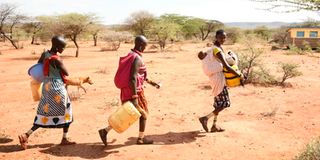As Kenyans starve, Cabinet delays meeting on drought and famine

Baringo, Kwale, Laikipia, Kitui, West Pokot and Lamu are among counties at risk of severe food shortages.
The Cabinet will meet on Tuesday next week to discuss how to help starving Kenyans as drought continues to ravage many parts of the country.
One of the measures being considered is the purchasing of livestock from pastoralists in areas hit hardest by food shortages. The State may also send money directly to affected households.
The National Development Implementation and Communication Cabinet Committee (NDICC) will create a programme to cushion livestock keepers. The State will buy animals from people in drought-stricken areas so that they will not incur losses when the animals die.
Agriculture Cabinet Secretary Peter Munya said Kenya has enough maize, a staple for many families, and the challenge is not the lack of food but the inability of Kenyans to buy the stock because of a cash crunch caused by the Covid-19 pandemic.
“The purchasing power that has been eroded by the Covid-19 situation and the drought is what must be addressed in this Tuesday meeting,” he said.
Meeting rescheduled
Speaking in Mombasa, Mr Munya said relevant ministries were to meet on Thursday but the meeting was rescheduled to next week.
“It’s an urgent matter. We are coming back with a programme we used to have to help pastoralists...that is livestock uptake. We will support livestock keepers with pasture and also buy their animals as part of intervening support,” he said.
But even as the drought bites, the minister urged Kenyans to start preparing for expected rains.
Twenty-three counties are grappling with drought, with Wajir, Garissa, Kilifi, Isiolo, Mandera, Marsabit and Tana River facing severe famine.
The government has set aside Sh1.5 billion to help Kenyans facing food shortages in these and other counties.
Little rains
“In the last two years or so we have not had sufficient rains to produce enough food. It’s not necessarily a very bad situation but it might worsen if we don’t get rains,” said government spokesperson Cyrus Oguna.
“The government will not distribute food. Instead it will give emergency relief assistance, that is Sh2,400 monthly. We also have the Inua Jamii programme.”
He said county governments are also distributing water in areas with shortages.
He cited Garissa, Tana River, Wajir, Marsabit and Isiolo as counties hit hardest by water shortages.
In the Coast region, residents of Lamu and Kilifi face famine, which has also affected learning in schools.
Grim picture
A few days ago, Devolution Cabinet Secretary Eugene Wamalwa said the drought was taking its toll in northern Kenya, with projections by the National Drought Management Authority painting a grim picture.
Mr Wamalwa said hundreds of livestock owned by nomadic communities had died.
A report by the International Programme for Action on Climate shows that about 541,700 children aged six months to four years and 98,800 pregnant or nursing mothers in arid counties require treatment for acute malnutrition.
This is attributed to reduced milk production in mothers and lower consumption among children, the main diet for the young in arid areas.





